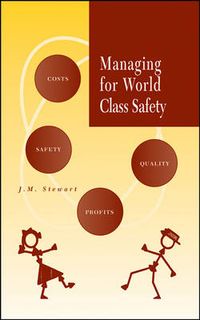
endast ny
Managing for World Class Safety Upplaga 1
Replace anecdotal guesswork with quantitative fact when evaluating safety management Despite the extensive literature on safety, few tools have been available to help managers quantitatively assess the level of safety management and the quality of the safety practices in organizations. In his consulting practice, Dr. Jim Stewart, a former executive at DuPont, developed such a method, crafting a safety survey centering on a comprehensive questionnaire for employees at all levels, that reveals the true level of corporate commitment to safety. Managing for World Class Safety first describes the model of safety management that underpins the questionnaire and then demonstrates how this innovative procedure illuminates critical intangibles like management commitment, the enforcement of rules, worker involvement, and injury investigation. The central part of this book is the description of research at the University of Toronto that applies the questionnaire in comprehensive research at five of the world’s safest companies and five with very poor safety. The questionnaire polled 700 people in the ten companies, "measuring" the level of more than twenty key elements such as: *The workers’ perception of the priority given to safety *The belief that all injuries can be prevented *The extent to which line management takes responsibility/accountability for safety *How well safety rules are followed and enforced *The frequency and quality of safety meetings *The level of recognition to reinforce safety excellence *In every element, the contrast between the responses from the very safe companies and those from the companies with poor safety was dramatic, clearly depicting where the former succeed and the latter fail By developing quantitative benchmark data, Stewart reasons that it will be easier to convince reluctant management to undertake the fundamental change necessary for a "step change" in their company performance. Managing for World Class Safety promises a revolutionary new approach to workplace safety improvement for corporate leaders, safety professionals, and regulators.
Upplaga: 1a upplagan
Utgiven: 2001
ISBN: 9780471443865
Förlag: John Wiley & Sons
Format: Inbunden
Språk: Engelska
Sidor: 296 st
Replace anecdotal guesswork with quantitative fact when evaluating safety management Despite the extensive literature on safety, few tools have been available to help managers quantitatively assess the level of safety management and the quality of the safety practices in organizations. In his consulting practice, Dr. Jim Stewart, a former executive at DuPont, developed such a method, crafting a safety survey centering on a comprehensive questionnaire for employees at all levels, that reveals the true level of corporate commitment to safety. Managing for World Class Safety first describes the model of safety management that underpins the questionnaire and then demonstrates how this innovative procedure illuminates critical intangibles like management commitment, the enforcement of rules, worker involvement, and injury investigation. The central part of this book is the description of research at the University of Toronto that applies the questionnaire in comprehensive research at five of the world’s safest companies and five with very poor safety. The questionnaire polled 700 people in the ten companies, "measuring" the level of more than twenty key elements such as: *The workers’ perception of the priority given to safety *The belief that all injuries can be prevented *The extent to which line management takes responsibility/accountability for safety *How well safety rules are followed and enforced *The frequency and quality of safety meetings *The level of recognition to reinforce safety excellence *In every element, the contrast between the responses from the very safe companies and those from the companies with poor safety was dramatic, clearly depicting where the former succeed and the latter fail By developing quantitative benchmark data, Stewart reasons that it will be easier to convince reluctant management to undertake the fundamental change necessary for a "step change" in their company performance. Managing for World Class Safety promises a revolutionary new approach to workplace safety improvement for corporate leaders, safety professionals, and regulators.
Ny bok
1772 kr1865 kr
5% studentrabatt med Studentapan
Begagnad bok (0 st)
Varje vecka tillkommer tusentals nya säljare. Bevaka boken så får du meddelande när den finns tillgänglig igen.



